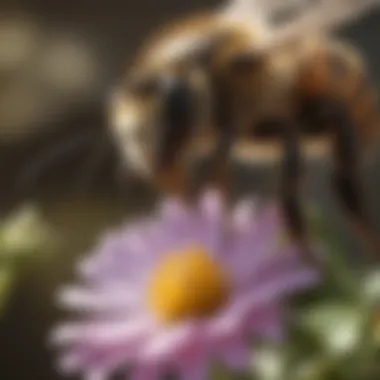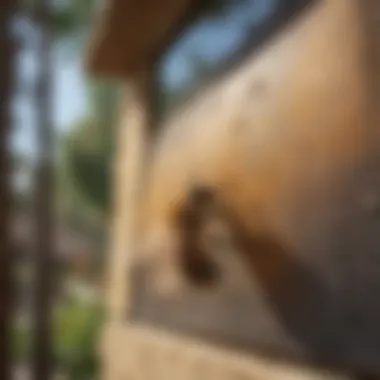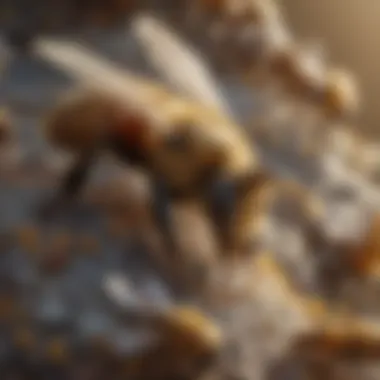Comprehensive Guide to Bee Removal in Chino


Intro
Bees play an essential role in our ecosystem, especially in urban environments like Chino. However, their presence can sometimes create challenges for homeowners and residents. Understanding how to manage bee interactions is crucial for balancing ecological needs with safety concerns. This guide aims to equip readers with the necessary knowledge for effective bee removal, emphasizing ethical practices and preventive measures.
Understanding Pests
Definition of Pests
In the context of urban living, pests are organisms that negatively impact human activities or health. This includes insects, rodents, and sometimes larger animals. Bees, despite their benefits in pollination, can be considered pests when they build hives in undesirable locations or create fears of stings.
Importance of Pest Identification
Identifying the type of bee is essential for determining the appropriate removal strategy. The most common species in Chino include honeybees and bumblebees. Each species has unique behaviors and nesting habits, which influence how homeowners should react when they encounter them.
Knowing whether the bees are aggressive or beneficial plays a key role in effective removal. Homeowners must avoid rash decisions and instead seek to understand their options.
Prevention Techniques
Home and Garden Preventative Measures
Preventing bee infestations starts at home. Here are several techniques homeowners can deploy:
- Seal Entry Points: Close off any cracks and crevices in walls or roofs to minimize nesting opportunities.
- Remove Attractants: Regularly clean food residues and manage garbage. Overripe fruit or open soda cans can attract bees.
- Maintain Landscaping: Be mindful of flowering plants. While these can attract bees for their pollination benefits, knowing which species are abundant can help in managing their presence.
Seasonal Prevention Tips
Different seasons bring different challenges. Here are seasonal tips:
- Spring: Monitor gardens for early signs of nesting. Keep outdoor spaces tidy.
- Summer: Avoid sugary food outdoors and consider introducing bee-repelling plants.
- Autumn: Inspect for developing hives and prepare for potential winter bee activity.
Eco-Friendly Pest Control Solutions
Overview of Sustainable Practices
When it comes to bee removal, sustainability should be a priority. Choosing eco-friendly methods protects both human safety and bee populations. Here are some practices:
- Professional Removal Services: Opt for licensed exterminators trained in humane capture methods.
- Bee Relocations: Many professionals offer services to relocate hives instead of extermination, maintaining ecological balance.
Natural Remedies and Their Effectiveness
For those who prefer DIY solutions, it is possible to create natural deterrents. Some methods include:
- Peppermint Oil Spray: Mixing peppermint oil with water can discourage bees from certain areas.
- Citrus Solutions: Bees tend to avoid citrus scents. Using lemon or orange peels around garden spaces can assist in keeping them at bay.
Important Note: Always approach bee removal with caution. Aggressive handling can lead to stings, and improper methods can harm bee populations.
These strategies are just the beginning. Understanding these principles will empower homeowners in Chino, providing a pathway to coexistence with these important pollinators.
Understanding Bees
Understanding bees is crucial for addressing the challenges they pose in urban environments like Chino. Bees are not just simple insects; they play a vital role in pollination and maintaining ecological balance. Their presence can lead to complex interactions with humans, especially when infestations occur. Having insights into the biology and behavior of bees aids in developing effective management and removal strategies.
This section aims to inform residents about the different species of bees in Chino, their habits, and what signs to look for when infestation occurs. By recognizing these aspects, homeowners and gardeners can make more informed decisions about preventing and managing bee populations effectively.
Biology of Bees
Bees belong to the order Hymenoptera and are closely related to wasps and ants. They have specialized mouthparts for collecting nectar and pollen. Most bees exhibit a distinctive body structure characterized by a hairy body that aids in pollen collection.
A worker bee can live several weeks, while the queen can live for several years. Bees have a well-structured society with a clear division of labor. This social behaviour helps ensure their survival and efficiency in pollination.
Types of Bees in Chino


While there are many types of bees, some are more commonly found in Chino. Understanding them helps home and garden owners respond appropriately to their presence.
Native Bees
Native bees are important for the local ecosystem. They are adapted to the specific plants in the area, making them effective pollinators. An advantage of native bees is that they often do not form large colonies like honey bees, which can minimize aggressive behaviors. They contribute to the diversity of local flora, benefiting gardens and farms. However, some native species may be less resilient to environmental changes, making their protection important.
Honey Bees
Honey bees are social bees known for producing honey. They live in large colonies and can become defensive if their hive is threatened. One key characteristic of honey bees is their ability to communicate through a dance, which helps other bees locate food sources. Their role in commercial agriculture is significant, as they pollinate many crops. However, their presence in urban areas can lead to human-wildlife conflicts, necessitating effective removal strategies.
Bumble Bees
Bumble bees are larger and fuzzier than honey bees. They are known for their ability to pollinate in cooler temperatures, making them important for early spring flowers. Their key strength is their ability to buzz pollinate, which is effective for certain plants like tomatoes. Bumble bees are generally less aggressive but can sting if provoked. This moderate behavior makes them a preferred option for gardens, but their colonies are smaller and less resilient than honey bees.
Carpenter Bees
Carpenter bees have a unique behavior of boring into wood to create nesting sites. They resemble bumble bees but have a shiny, smooth abdomen. This wood-boring habit can cause damage to structures, making them a concern for homeowners. While they do not aggressively sting, their presence in wood can lead to structural compromise. The benefit of carpenter bees includes their role in pollination, yet their potential for property damage often necessitates removal actions.
Behaviors and Habitats
Bees thrive in various habitats, including gardens, parks, and wild areas in Chino. They are typically drawn to blooming flowers as their primary food source. Understanding their behaviors, such as foraging patterns and nesting habits, enables homeowners to create more bee-compatible environments. By recognizing areas where bees are more likely to establish nests, precautions can be taken to minimize unwanted interactions.
"Presence of bees in the environment is an indicator of ecological health. Understanding them helps maintain balance. "
In summary, a firm grasp of bee biology, the types found in Chino, and their behaviors will guide effective removal and management practices. This understanding provides homeowners with tools for sustainable living alongside these essential pollinators.
Identifying Bee Infestations
Identifying bee infestations holds significant importance for homeowners in Chino. Unattended bee colonies can lead to safety hazards, property damage, and ecological imbalance. Knowing how to identify the presence of bees is the first step in addressing any subsequent issues. Early recognition of an infestation allows for timely intervention, minimizing risks and promoting safer environments.
Signs of Infestation
Visual Indicators
Visual indicators play a crucial role in detecting bee infestations. Common signs include an unusual number of bees around your property, particularly near entrances or exits, and the presence of nests under eaves or in attics. Observing these factors early can prevent more severe problems from developing. When visual cues are noticeable, it is beneficial to act quickly. Key characteristics of these indicators include sheer presence and activity patterns of bees. If bees are flying in and out consistently from a specific area, it is a clear, strong sign of an infestation. However, one should distinguish recreational bee activity from an established nest.
A unique aspect of visual indicators is the ability to observe behavioral patterns. A visible hive can offer insights into the species of bees, which is essential for determining the best removal approach. In terms of advantages, recognizing these signs means quicker responses. The downside may be the risk of misidentifying bee species, which can lead to improper removal strategies.
Sound Identification
Sound identification contributes effectively to recognizing bee infestations. The characteristic buzzing sound is a reliable indicator of an active colony nearby. Pay attention to the frequency and intensity of the sounds. A higher volume can indicate a more significant presence of bees, which may require immediate action.
The key characteristic of sound identification is its ability to alert a homeowner long before visual presence is confirmed. If a consistent buzzing sound can be heard within a space like walls or ceilings, it is more than likely an indication of a bee hive. A distinctive aspect of this technique is the subtlety it provides before a possible visual confrontation with the swarm.
Advantages include early detection without proximity to the nest, limiting exposure to potential stings. The disadvantage can be that some people may confuse the buzzing with other insects, such as wasps, leading to misinformation.
Differentiating Bees from Wasps
Differentiating between bees and wasps is critical for effective pest management. While both insects share similar habitats, their behavior and physical traits are quite distinct. Bees typically have a more rounded body and are generally hairier than wasps. This hairiness aids in pollen collection. Wasps, on the other hand, have smoother bodies and can appear more slender.
Additionally, understanding their behavior aids in recognition. Bees focus on pollination and are less aggressive unless threatened. Wasps are more protective of their nests and can be more aggressive, especially during late summer when their food sources decline.
Recognizing these differences helps in choosing appropriate removal strategies. Proper identification prevents unnecessary harm to beneficial bee populations while addressing potential wasp threats.
Legal Considerations for Bee Removal
Understanding the legal aspects of bee removal is crucial. In Chino, as in many urban areas, there are regulations designed to protect local ecosystems and ensure that bee removal is conducted humanely and safely. Engaging with these legal considerations not only helps homeowners avoid potential fines but also promotes a responsible approach to pest management.
Local Regulations
Homeowners in Chino must be aware of local regulations regarding bee removal. The city may have specific laws that dictate how bees can be safely removed from residential areas. Typically, these regulations require residents to seek professional help for bee removal instead of attempting DIY methods. This minimizes risks to both people and the bees themselves.
Moreover, certain permits may be necessary for removing beehives. It is advisable to contact local authorities or consult with pest control experts to understand current regulations. Following these laws is not only important for compliance but also contributes to the ecological well-being of the area.


Endangered Species Protections
In addition to local laws, homeowners should consider the protections in place for endangered bee species. Some bees, like the Crotch's bumblebee, are recognized for their declining populations. The law often mandates that homeowners refrain from removing or harming these protected species inadvertently. This means that before any removal process begins, it is important to identify the type of bee present.
Protective measures may even include relocation instead of extermination. Organizations and professionals trained in ecological standards can help ensure that the removal process is compliant with environmental laws. This not only safeguards the bees but also aids community efforts to maintain biodiversity.
"Considering legal and ethical implications in bee removal sustains urban ecosystems while maintaining public safety."
In summary, understanding local regulations and protecting endangered species are fundamental components in the bee removal process. Employing professional services ensures that these considerations are incorporated, promoting a balanced approach to pest control that respects both human needs and wildlife conservation.
Methods of Bee Removal
Bee removal requires careful consideration because of the ecological importance of bees and the potential danger they pose to humans. Choosing the right method can significantly influence the outcome of the removal process. It is crucial to assess the situation responsibly, balancing the need for safety with respect for these essential pollinators. This section explores both professional services and DIY techniques, outlining their advantages and key elements that stakeholders should consider.
Professional Services
Benefits of Hiring Experts
Engaging professionals for bee removal offers numerous benefits. One significant aspect is the expertise that trained technicians bring to the table. These experts are familiar with bee behaviors, habitats, and effective removal strategies. This understanding reduces the risk of unforeseen complications during the removal process.
Moreover, professional services often employ methods that minimize harm to the bees when possible. They can relocate swarms instead of exterminating them, contributing to ecological balance. The high level of training and experience translates into safer and more effective removal techniques, making this option highly beneficial for homeowners who wish to avoid risks associated with improper removal methods.
What to Expect from Services
When you hire professionals for bee removal, you can expect a structured process. First, they will conduct a thorough assessment of the infestation. This evaluation helps determine the extent of the bee population and the most appropriate removal method. Experts typically explain their approach, providing clarity on what will happen during the removal. Following the process, they may offer guidance on preventing future infestations, adding value to their service.
The transparency and thoroughness of professional services mean that homeowners can feel secure throughout the process. However, it's important to note that this option often comes at a higher cost compared to DIY methods, which may deter some customers. Yet, for those prioritizing safety and ecological considerations, hiring experts remains a popular choice.
DIY Removal Techniques
Safety Precautions
When considering DIY removal techniques, safety precautions are paramount. Taking proper safety measures is essential to avoid potential stings or harmful encounters with bees. Homeowners should wear protective clothing, including gloves, long sleeves, and a bee veil if necessary. Having a friend or neighbor to assist is also advisable, as an extra set of hands can help manage any unexpected situations or emergencies.
Another key aspect of safety is timing. Removing bees early in the morning or late in the evening, when they are less active, can significantly reduce the risk of stings. While DIY removal can save money, it is important to recognize that improper handling can lead to serious injuries, making safety the foremost concern.
Necessary Equipment
The right equipment is vital for effective DIY bee removal. Basic tools include a bee smoker, hive tool, and a bee box for safe transport if you plan to relocate the hive. A bee smoker helps calm the bees, reducing aggression during the removal process. Additionally, proper ventilation is necessary to ensure the bees remain unharmed during transportation.
Homeowners may also consider using natural repellents or traps, but it is important to research these methods thoroughly to avoid harming the bees unnecessarily. DIY techniques can offer flexibility and cost savings; however, utilizing the right tools and following recommended practices is critical to executing these options safely.
Be mindful that improper handling during DIY efforts can lead to unintended consequences, including attacks from agitated bees.
Bee Removal Process
The bee removal process is central to managing bee infestations in urban settings like Chino. Understanding this process is essential for homeowners aiming to maintain safety while also considering ecological impacts. Proper bee removal can prevent potential stings and property damage while ensuring that the environment is respected. The process involves several stages, each critical for an effective outcome.
Assessment of the Situation
Before any action is taken, assessing the situation is paramount. This step involves identifying the presence of bees and understanding their location and behavior. Homeowners should look for signs such as buzzing sounds or visible nests. Conducting a thorough inspection is beneficial as it allows for a tailored removal strategy.
During the assessment, one should note:
- The type of bee involved, which can influence removal methods.
- The proximity of the nest to human activity, such as heavy traffic areas of the home or garden.
- Time of day, since bees are less active in cooler hours.
By evaluating these elements, homeowners can not only gauge the urgency of the situation but also strategize on the safest and most efficient approach to removal.
Execution of Removal
Once the situation is assessed, the next phase involves executing the removal. This phase is where careful consideration of techniques is necessary for ensuring safety and effectiveness.


Techniques Used
Various techniques exist for bee removal, including both chemical and non-chemical methods. Non-chemical methods, such as trapping or relocating bees, are increasingly popular for their environmental benefits. On the other hand, chemical methods often involve insecticides which can be effective but may pose risks to other pollinators.
The choice of technique often focuses on:
- Effectiveness: Some methods guarantee quick results, while others require time.
- Impact on the environment: Eco-friendly methods are preferred to minimize harm to ecosystems.
- Safety for humans and pets: Techniques that reduce exposure risks are favored,
- Long-term viability: Options that prevent re-infestation are essential.
Overall, the method chosen will directly affect the success of the overall removal process.
Post-Removal Considerations
Once the bees have been removed, post-removal considerations play a critical role. It is vital to ensure that any gaps or entry points in the home are sealed to prevent future infestations.
Key aspects to consider include:
- Cleaning Infestation Areas: Removing any honey or pheromones that might attract new bees can help in deterring future problems.
- Monitoring for Activity: Observing the area for signs of returning bees is crucial. This can inform whether further actions are necessary.
- Consultation with Specialists: Following removal, consulting with pest control professionals can provide insights on maintaining bee-free zones.
Aftercare and Monitoring
Aftercare involves ongoing monitoring and possible maintenance to ensure that bees do not return. Regular inspections should be carried out, especially during warm seasons when bees are most active. Homeowners should also stay informed about local mason bee activities, especially as they can be beneficial pollinators if managed properly.
With these measures implemented, it is possible to achieve a balance between safety and ecological awareness, maintaining a harmonious environment in Chino.
Preventing Future Infestations
Preventing future infestations is a critical aspect of managing bee populations in urban settings like Chino. It is far more effective to engage in proactive measures than to deal with the aftermath of an infestation. Homeowners can save time, money, and potential distress by understanding how to minimize attractants and enhance their landscape to be less inviting to bees.
Identifying Attractants
An important first step in prevention is identifying what specifically attracts bees to your property. Bees are generally drawn by food sources and shelter. Here are some factors to consider:
- Flowering Plants: Certain plants are more appealing to bees. Flowers with abundant nectar and pollen, such as lavender, sunflowers, and clover, are known for attracting them.
- Water Sources: Bees need water for hydration and to maintain their hives. Puddles, bird baths, or a leaking hose can serve as watering points, enticing bees to linger nearby.
- Food Waste: Leftover food scraps can be a significant attractant. Compost piles, garbage bins, or even your outdoor dining area can become hotspots if not properly managed.
- Nest Sites: Bees often seek out sheltered areas for nesting. Gaps in walls, eaves, or porch overhangs can make perfect homes for them.
By being aware of these attractants, homeowners can take steps to eliminate or reduce their appeal.
Creating a Bee-Friendly Landscape
While it may seem counterintuitive, a well-planned landscape can help prevent problematic infestations. By designing a bee-friendly landscape, homeowners can support local ecosystems while minimizing hazards:
- Plant Selection: Choose plants that are less attractive to bees. Opt for less nectar-rich flora and consider non-flowering plants to reduce interest.
- Spatial Arrangement: Position plants that attract bees away from high-traffic areas of your property. This includes pathways and children's play areas.
- Water Management: Ensure that standing water is not easily available. Regularly empty bird baths or other water containers that may attract bees.
- Maintenance Practices: Keep the garden tidy. Dead blooms and overgrown plants can attract bees, so regular pruning and cleaning are key.
Creating a thoughtfully designed garden is not only good for bee prevention but can also enhance the beauty of your home environment. You can find more insights regarding bees and their behaviors on Wikipedia and Britannica.
It’s essential to understand that sustainable management of bee populations not only protects your property but also benefits the environment as a whole.
By implementing these preventive strategies, homeowners can significantly reduce the likelihood of future bee infestations, ensuring a safer and more enjoyable living environment.
Ending
The conclusion of this guide holds significant weight in providing clarity on the complexities surrounding bee removal in Chino. It encapsulates the essentials discussed throughout the article, serving as a final reference for homeowners seeking a thorough understanding of their options. The importance of informed decision-making stands out, especially when dealing with the delicate balance of ecological preservation and personal safety.
Summary of Key Points
In summary, this article has explored various facets of bee removal. Key points include:
- Understanding Bees: An overview of the types of bees in Chino and their habitats.
- Identifying Bee Infestations: Recognizing the signs of bee presence and differentiating them from wasps.
- Legal Considerations: Knowing local regulations and protections for endangered bee species.
- Methods of Bee Removal: Weighing the benefits of professional services versus DIY techniques.
- The Bee Removal Process: Detailed steps from assessment to aftercare.
- Preventing Future Infestations: Strategies to minimize attractants and promote a safe environment.
These points ensure readers grasp the importance of careful bee management.
Final Thoughts on Sustainable Bee Management
Sustainable bee management practices are critical for harmonious living in areas like Chino. Rather than simply removing bees, the focus should be on coexistence. Homeowners can create environments that discourage infestations while supporting local bee populations.
Encouraging biodiversity in gardens not only enriches the local ecosystem but also enhances the health of communities. Also, being proactive in maintaining spaces can significantly reduce future encounters. Understanding the importance of these insects in our ecosystem is paramount, and adopting sustainable methods ensures that both human safety and ecological balance are preserved.
"The health of our ecosystems depends on the respect and management of all its inhabitants, including bees."
Engaging with both professional and community resources to stay informed is essential. This guide serves as a foundational step towards smart and sustainable bee management.



